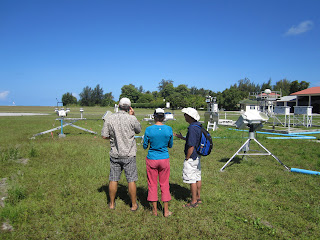We are modelers in a field program. It is one of our goals to understand how the observation data we use is made. I'd like to share what I experienced in my visiting to the second ARM mobile facility (AMF2) site. AMF2 is a part of AMIE (ARM MJO investigation experiment) project, which is a brother field campaign with DYNAMO. Dr. Charles Long from Pacific Northwest National Laboratory kindly introduced all the instruments in AMF2 to DYNAMO scientists including me.
 Dr. Charles Long (right) is giving an introduction to instruments to DYNAMO scientists.
Dr. Charles Long (right) is giving an introduction to instruments to DYNAMO scientists. This total sky imager takes a picture of whole sky in every few seconds. So later on we know how much cloud was there on a certain day.
This total sky imager takes a picture of whole sky in every few seconds. So later on we know how much cloud was there on a certain day. This microwave radiometer measures the amount of three phases of water, those are vapor, liquid, and ice, in the atmosphere.
This microwave radiometer measures the amount of three phases of water, those are vapor, liquid, and ice, in the atmosphere.I found there were two ways to measure surface shortwave radiation from Sun.
 The crystal ball concentrates sunlight into one point beneath it and it burns the paper under the ball. The paper is burned severely in a day of strong sunshine. Note that this instrument belongs to Maldivian Meteorological Service and is not a part of AMF2.
The crystal ball concentrates sunlight into one point beneath it and it burns the paper under the ball. The paper is burned severely in a day of strong sunshine. Note that this instrument belongs to Maldivian Meteorological Service and is not a part of AMF2. After all introductions, it was a time to launch a radiosonde. In AMF2, people launch the radiosonde 8 times a day, so in every 3 hours. Luckily, I got a chance to do that and waiting for a sign to launch a radiosonde. The helmet is just for biking and not necessary for a person who launches a sonde.
After all introductions, it was a time to launch a radiosonde. In AMF2, people launch the radiosonde 8 times a day, so in every 3 hours. Luckily, I got a chance to do that and waiting for a sign to launch a radiosonde. The helmet is just for biking and not necessary for a person who launches a sonde.





No comments:
Post a Comment